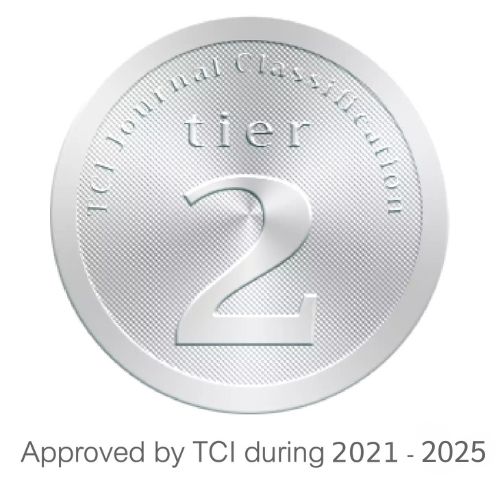ผลลัพธ์ที่ไม่คาดคิดของตัวแปรเพศในการวัดการอู้งาน: การทดลองออนไลน์ชี้นำการอ้างอิงแหล่งควบคุมในกลุ่มนิสิต ที่มีลักษณะการอ้างอิงแหล่งควบคุมที่แตกต่างกัน เพื่อลดพฤติกรรมการอู้งานในกลุ่ม
Unexpected Result of Gender Variable in Social Loafing Evaluation: Online Experiment on Priming Locus of Control in Student’s Different Traits of Locus of Control to Reduce Social Loafing Behavior in Work Group
Keywords:
ลักษณะการอ้างอิงแหล่งควบคุม, การชี้นำการอ้างอิงแหล่งควบคุม, พฤติกรรมการอู้งานAbstract
การวิจัยครั้งนี้มีจุดประสงค์เพื่อศึกษาการชี้นำการอ้างอิงแหล่งควบคุมในบุคคลที่มีลักษณะการอ้างอิงแหล่งควบคุมที่แตกต่างกันเพื่อลดพฤติกรรมการอู้งานในการทำงานเป็นกลุ่ม กลุ่มตัวอย่างคือ นิสิตปริญญาตรีอายุ 18 – 24 ปี จำนวน 171 คน การศึกษานี้เป็นการศึกษาแบบ Factorial 2X2 (ลักษณะการอ้างอิงแหล่งควบคุม X การชี้นำการอ้างอิงแหล่งควบคุมภายใน) โดยแบ่งเป็น 1) กลุ่มลักษณะการอ้างอิงแหล่งควบคุมภายในที่ผ่านการชี้นำการอ้างอิงแหล่งควบคุมภายใน 46 คน 2) กลุ่มลักษณะการอ้างอิงแหล่งควบคุมภายนอกที่ผ่านการชี้นำการอ้างอิงแหล่งควบคุมภายใน 44 คน 3) กลุ่มลักษณะการอ้างอิงแหล่งควบคุมภายในที่ไม่ผ่านการชี้นำใดๆ 49 คน และ 4) กลุ่มลักษณะการอ้างอิงแหล่งควบคุมภายนอกที่ไม่ผ่านการชี้นำใดๆ 32 คน ในลักษณะของการศึกษาแบบกึ่งการทดลองผ่านออนไลน์ โดยมีพฤติกรรมการอู้งานในการทำงานเป็นตัวแปรตาม งานวิจัยมีการเก็บข้อมูลแบ่งเป็น 2 ช่วง ช่วงคัดเข้าและช่วงทดลอง โดยช่วงคัดเข้าจะเป็นการทำแบบสอบถามผ่าน Google Form เป็นมาตรวัดลักษณะการอ้างอิงแหล่งควบคุม (เพื่อแบ่งกลุ่มผู้เข้าร่วมการวิจัยออกเป็นกลุ่มที่มีลักษณะการอ้างอิงแหล่งควบคุมภายใน และภายนอก) จากนั้นจะมีการนัดหมายผู้เข้าร่วมการวิจัยมาเข้าร่วมในช่วงทดลองผ่าน Zoom Meeting ซึ่งผู้เข้าร่วมการวิจัยจะถูกสุ่มเข้าเงื่อนไขจัดกระทำเงื่อนไขใดเงื่อนไขหนึ่ง (เงื่อนไขชี้นำการอ้างอิงแหล่งควบคุมภายใน หรือเงื่อนไขควบคุม) ก่อนที่ช่วงทดลองจะเริ่ม ในช่วงทดลองนี้ผู้เข้าร่วมจะได้ทำงานชี้นำตามเงื่อนไข จากนั้นทำการวัดพฤติกรรมการอู้งานโดยให้ผู้เข้าร่วมทำงานระดมความคิดออนไลน์ เมื่อเสร็จสิ้นแล้วผู้วิจัยทำการอธิบายจุดประสงค์ที่แท้จริงให้แก่ผู้เข้าร่วมการวิจัยฟัง ผลการวิจัยพบว่า ลักษณะการอ้างอิงแหล่งควบคุมและการชี้นำการอ้างอิงแหล่งควบคุมไม่มีทั้งอิทธิพลหลักหรือปฏิสัมพันธ์กันต่อพฤติกรรมการอู้งานอย่างมีระดับนัยสำคัญ อย่างไรก็ตามผู้วิจัยกลับพบว่าตัวแปรเพศมีอิทธิพลต่อพฤติกรรมการอู้งานในงานวิจัยนี้ เนื่องจากผู้เข้าร่วมการวิจัยเพศชายมีแนวโน้มที่จะมีแรงจูงใจในการทำงานระดมความคิดออนไลน์มากกว่าเพศหญิง ซึ่งเป็นงานที่ให้คิดการใช้งานของมีดออกมาให้ได้มากที่สุดเท่าที่จะสามารถคิดได้ เป็นข้อค้นพบว่าตัวแปรเพศนั้นสามารถมีอิทธิพลต่อพฤติกรรมการอู้งานได้เช่นกัน หากงานดังกล่าวเป็นประเภทงานที่ผู้ชายกับผู้หญิงมีแรงจูงใจในการทำต่างกันReferences
วาริธร อุดมเวช (2557). อิทธิพลของเป้าหมายการให้ของขวัญ ต่อการเลือกซื้อสินค้าโชคลาง โดยมีความนับถือโชคลาง การอ้างอิงแหล่งควบคุมภายใน และรูปแบบการประมวลข้อมูลเป็นตัวแปรกำกับ. วิทยานิพนธ์ศิลปศาสตรมหาบัณฑิต (จิตวิทยา). กรุงเทพฯ: คณะจิตวิทยา จุฬาลงกรณ์มหาวิทยาลัย. https://cuir.car.chula.ac.th/bitstream/123456789/44515/1/5477615538.pdf
Faul, F., Erdfelder, E., Lang, A.-G., & Buchner, A. (2007). G*Power 3: A Flexible Statistical Power Analysis Program for the Social, Behavioral, and Biomedical Sciences. Behavior Research Methods. 39(2): 175–191. https://doi.org/10.3758/bf03193146
Fini, A. A., & Yousefzadeh, M. (2011). Survey on Relationship of Achievement Motivation, Locus of Control and Academic Achievement in High School Students of Bandar Abbas (Iran). Procedia - Social and Behavioral Sciences. 30: 866–870. https://doi.org/10.1016/j.sbspro.2011.10.168
Fisher, K., & Johnstion, M. (1996). Experimental Manipulation of Perceived Control and Its Effect on Disability. Psychology & Health. 11(5): 657–669. https://doi.org/10.1080/08870449608404995
Harkins, S. G., & Petty, R. E. (1982). Effects of Task Difficulty and Task Uniqueness on Social Loafing. Journal of Personality and Social Psychology. 43(6): 1214–1229. https://doi.org/10.1037/0022-3514.43.6.1214
Hellendoorn, J., & Harinck, F. J. H. (1997). War toy Play and Aggression in Dutch Kindergarten Children. Social Development. 6(3), 340–354. https://doi.org/10.1111/1467-9507.00042
Higgins, T. E. (1996). Knowledge Activation: Accessibility, applicability, and Salience. In T. E. Higgins & A. W. Kruglanski (Eds.), Social Psychology: Handbook of Basic Principles (pp. 133–168). New York, NY: Guilford Press
Hoon, H., & Tan, T. M. L. (2008). Organizational Citizenship Behavior and Social Loafing: The Role of Personality, Motives, and Contextual Factors. The Journal of Psychology. 142(1): 89-108. https://doi.org/10.3200/JRLP.142.1.89-112
Judge, T. A., Locke, E. A., Durham, C. C., & Kluger, A. N. (1998). Dispositional Effects on Job and Life Satisfaction: The Role of Core Evaluations. Journal of Applied Psychology. 83(1): 17-34. https://doi.org/10.1037/0021-9010.83.1.17
Karau, S. J., & Williams, K. D. (1993). Social Loafing: A Meta-Analytic Review and Theoretical Integration. Journal of Personality and Social Psychology. 65(4): 681–706. https://doi.org/10.1037/0022-3514.65.4.681
Kaufman, J. C. (2012). Kaufman domains of Creativity Scale. PsycTESTS Dataset. Retrieved October 15, 2022, from https://doi.org/10.1037/t17613-000
Klehe, U.-C., & Anderson, N. (2007). The Moderating Influence of Personality and Culture on Social Loafing in Typical Versus Maximum Performance Situations. International Journal of Selection and Assessment. 15(2): 250–262. https://doi.org/10.1111/j.1468-2389.2007.00385.x
Kong, Y., & Shen, F. (2011). Impact of Locus of Control on Health Message Effectiveness. Health Marketing Quarterly. 28(4): 354–371. https://doi.org/10.1080/07359683.2011.623114
Latané, B., Williams, K., & Harkins, S. (1979). Many Hands Make Light the Work: The Causes and Consequences of Social Loafing. Journal of Personality and Social Psychology. 37(6): 822–832.
Latané, B. (1981). The Psychology of Social Impact. American Psychologist. 36(4): 343–356. https://doi.org/10.1037/0003-066X.36.4.343
Ofole, N. M. (2022). Social Loafing Among Learner Support Staff for Open and Distance Education Programmes in South-Western Nigeria: The Imperative for Counselling Intervention. Open Learning: The Journal of Open, Distance and e-Learning. 37(1): 84–101. https://doi.org/10.1080/02680513.2020.1736020
Ottley, A., Crouser, R. J., Ziemkiewicz, C., & Chang, R. (2012). Priming Locus of Control to Affect Performance. 2012 IEEE Conference on Visual Analytics Science and Technology (VAST). Retrieved October 15, 2022, from https://scholarworks.smith.edu/cgi/viewcontent.cgi?article=1142&context=csc_facpubs
Purwanalisia, W., & Rinaldi. (2020). Hubungan Locus Of Control Dengan Social Loafing Mahasiswa UNP pada Tugas Kelompok. Jurnal Pendidikan Tambusai. 4(3), 3536–3543. Retrieved October 15, 2022, from https://jptam.org/index.php/jptam/article/view/883
Ringelmann, M. (1913). Research on Animate Sources of Power: The Work of Man. Annales de L’Instuit. National Agronomique. 12: 1–40.
Rotter, J. B. (1966). Generalized Expectancies for Internal Versus External Control of Reinforcement. Psychological Monographs: General and Applied. 80(1): 1–28. https://doi.org/10.1037/h0092976
Rotter, J. B. (1966). Rotter’s internal-external control scale. PsycTESTS Dataset. Retrieved October 15, 2022, from https://doi.org/10.1037/t01671-000
Simanjuntak, P. D. R., & Eliana, R. (2020). Correlation Between Locus of Control with Student’s Social Loafing in Group Task. International Journal on Social Science, Economics and Art. 9(4): 190-195. https://doi.org/10.35335/ijosea.v9i4.39
Sulikowski, D., & Burke, D. (2014). Threat Is in the Sex of the Beholder: Men Find Weapons Faster Than Do Women. Evolutionary Psychology. 12(5): 147470491401200. https://doi.org/10.1177/147470491401200505
Sumantri, M. A., & Pratiwi, I. (2020). Locus of Control: Upaya Untuk Menurunkan Social Loafing. Jurnal Ilmiah Psikologi Terapan. 8(1): 10. https://doi.org/10.22219/jipt.v8i1.7846
Ying, X., Li, H., Jiang, S., Peng, F., & Lin, Z. (2014). Group Laziness: The Effect of Social Loafing on Group Performance. Social Behavior and Personality: An International Journal. 42(3): 465-472. https://doi.org/10.2224/sbp.2014.42.3.465








